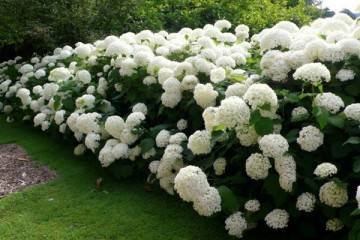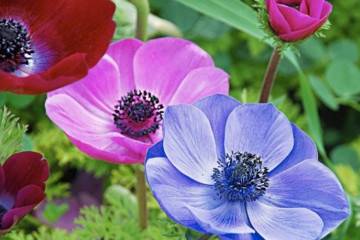Hydrangea Candelite - description and cultivation of the variety in the open field
Content:
Each summer resident seeks to decorate his site with at least one flower garden. Today, a huge number of annual and perennial plants are sold. The buyer is faced with the difficult task of choosing. While in thought, everyone studies the literature and looks for suitable options. And among the hundreds of varieties of garden flowers, almost everyone's eyes fall on hydrangeas. These are flowers of extraordinary beauty. Breeders are working to create new varieties with unique characteristics. And among them, the Candelite hydrangea stands out favorably, with a description of which can be found below.
Description of hydrangea Candelite
Hydrangea candelite (Hydrangea paniculata candelight) is an ornamental, stem-growing and lushly flowering Dutch plant. The bush grows quite large. In height, under favorable conditions, it can stretch up to 1.5 meters, and the crown reaches 2 meters in diameter.
The shoots are strong and strong, and their tops are decorated with cone-shaped inflorescences, which consist of many flowers. Small ones are fruitful, and beautiful large ones are sterile. The fruit is a small seed box. They form at the end of August.
Candelite bloom begins in mid-June and lasts until October. At first, the flowers have a delicate yellow-green color, which changes to white. By autumn, they acquire a pink tint, and by the end of the period - red. Below the stem grow bright green elliptical leaves. Their edges are jagged.
Many people do not correctly translate the Latin name of the variety. Therefore, on the Internet, you can find a variety of names:
- Candlelight hydrangea;
- panicle hydrangea candlelight;
- hydrangea candlelight;
- kendlight;
- candlelight.
Planting varieties in the ground
Planting a variety is a key moment in the cultivation and cultivation of decorative flowers. With the beginning of early spring and the opening of the summer cottage season, it is necessary to start planting Candelite in open ground. At this time, sap flow did not begin, so adaptation will occur as gently and quickly as possible.
Choosing the right place
The right place for hydrangea paniculata candelight guarantees vigorous growth and lush flowering. This variety does not tolerate drafts, is patient with the sun, but still prefers to stay in partial shade.
The best solution would be to plant a bush near fences or near the wall of the house. The thick shade will protect the delicate petals from the direct rays of the sun.
It is also important to consider that Candelite is a hydrangea that does not tolerate excessive moisture. When determining the future place, it is imperative to check it for the presence of groundwater.
Soil for hydrangea Candelite
Highly acidic soil is ideal for this ornamental shrub. Avoid areas with sand and alkaline compounds. In them, the plant will not be able to develop and bloom correctly.
Experienced flower growers note that the most lush flowering is observed in the inhabitants of the clay soil. To prevent moisture from evaporating quickly, a layer of peat or tree bark mulch is laid on the surface.
Planting process
First you need to prepare the holes. They should be large enough to accommodate the entire root system. The recommended diameter and depth is at least 40-50 cm. When planting several bushes in a row, a distance of about 2.5 meters must be observed between them.
It is advisable to prepare a soil mixture from:
- fertile soil;
- peat;
- humus.
The components are mixed in a 2: 1: 1 ratio, laid out on the bottom and moistened abundantly. When the moisture is completely absorbed and the soil settles, you can add the first top dressing of potassium sulfate (20 grams), superphosphate (60 grams) and urea (20 grams).
When the hole is completely ready, you need to tackle the bush. All roots are carefully straightened and evenly distributed along the bottom. The earth is poured on top and compacted.
The surface is moistened abundantly and more earth is added if necessary. The trunk circle is mulched with needles, leaf humus or peat. This will prevent drying out. For the adaptation period, which lasts a week, it is necessary to provide the flowers with a thick shade.
Reproduction of panicle hydrangea Candelite
This shrub reproduces easily. The grower can use 3 main methods:
- Cuttings
Planting material is prepared in the middle of summer. To do this, cuttings 8-15 cm long are cut from the strongest young shoots. It is better to cut the cut closer to the base, retreating 2 cm from the first bud.
Next, the prepared twig is placed in a container with a root growth stimulator. After the appearance of the first roots, the seedlings are planted in pots with a soil mixture of fertile soil and sand in a ratio of 2: 1.
As it grows and develops, the size of the pot increases. Young bushes do not like abrupt changes of residence, so it is better to grow them in pots for several years.
When the seedling turns 3 years old, it can be transplanted into open ground.
- Seeds
This is a less popular method. Planting material can be sown in containers or directly into open ground.
Choosing the second option, you should regularly carry out preventive treatment with drugs against diseases and pests.
- Layers
For reproduction, you need to take a young strong shoot. It is tilted and sprinkled with earth on top.
After some time, its own root system begins to develop, which makes it possible to separate it and move it to a new site.
Variety care
A pleasant and neat appearance of the bush, abundant flowering and active growth are an indicator of high-quality, well-planned and competent care. Hydrangeas cannot be classified as particularly demanding flowers, but it is still better to adhere to the simple rules of care, the description of which is presented below.
Watering and fertilizing
Like all varieties, the Candelite hydrangea needs regular watering. At the same time, she does not tolerate stagnation of water and an excess of moisture. If the soil on the site does not conduct water well, then a drainage layer can be laid out on the bottom. It is recommended to direct the stream of water to the root zone in order to avoid droplets falling on the leaves.
Top dressing is applied 4 times for the whole season:
- in the spring, before flowering, it is recommended to pour in organic matter (bird droppings or horse manure);
- at the time of bud formation, a mixture of superphosphate, potassium sulphide, urea is suitable;
- mineral supplements are applied in the middle of summer;
- in the fall, to prepare for winter, phosphorus-potassium preparations are introduced into the soil to increase frost resistance.
Shrub pruning
It is recommended to cut off old non-viable shoots in early spring, when the snow has just melted. In this case, about 5-7 of the strongest branches are left, shortening them to about 5 buds.
Mature shrubs rejuvenate by cutting everything to a level of 7 cm from the soil.
Possible problems
In the open field, the Candelite hydrangea is awaiting many diseases and pests. Noticing them at the initial stage and starting treatment in a timely manner, you can save your favorite plant.
Most often, the flowering shrub is affected by powdery mildew, which manifests itself in the form of a white bloom, which becomes brown as it develops. The second common enemy of a lush flowering bush is aphids. She feeds on juice, so the leaves can dry, turn yellow and fall off.
It is best to use a fungicide solution to combat these ailments. As a preventive measure, a weak solution of phosphorus and potassium can be introduced into the soil.
A spider mite can appear due to a lack of moisture in the soil. A soap solution, "Actellik" or "Karbofos" helps against the tick.
Due to the fact that the Candelite hydrangea loves well-moistened soil, a fungal disease can begin to develop in the root system. Darkness, humidity and warmth are the best conditions for its propagation. It is the root system that suffers, but outwardly the disease manifests itself in the form of wet brown spots.
Nematodes also attack the roots of the flower. With these two problems that have arisen, the flower is treated with Bordeaux liquid. However, the bush is almost impossible to heal and restore. In most cases, he dies. If one bush has died, then the gardener is advised to revise the watering regime and prevent it with a fungicide solution.
You can also often see insects: snails, bedbugs, leaf beetles, weevils. They all feed on juicy leaves, leaving behind irreparable marks. To combat them, it is recommended to use insecticides.
Preparing for winter
Hydrangea Candlelight tolerates frost and cold. Therefore, there is no need to worry about the plant. However, some gardeners prefer to play it safe - mulch the root area and lay spunbond to protect the roots.
However, owners of young bushes of Candelite panicle hydrangea, whose age does not exceed 3-4 years, are recommended to cover the shrub. Upon reaching this age, he will get stronger and will no longer need protection from wind and frost.
Candelite panicle hydrangea is a plant of amazing beauty that has struck the hearts of many flower growers. She gratefully responds to care and rewards her owner with a long flowering. This decorative bush will undoubtedly become the favorite of every gardener.





















